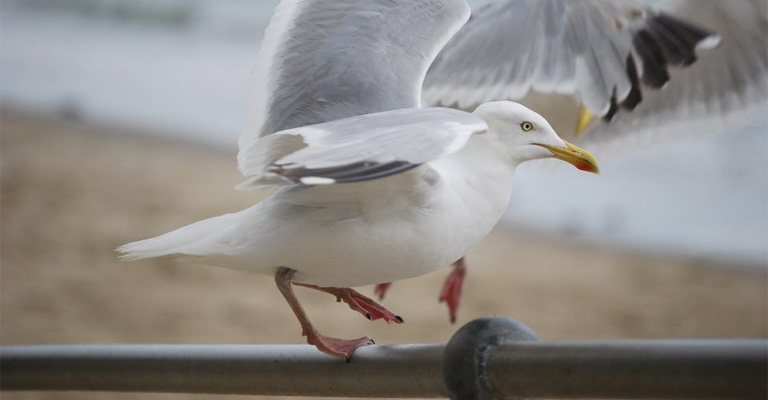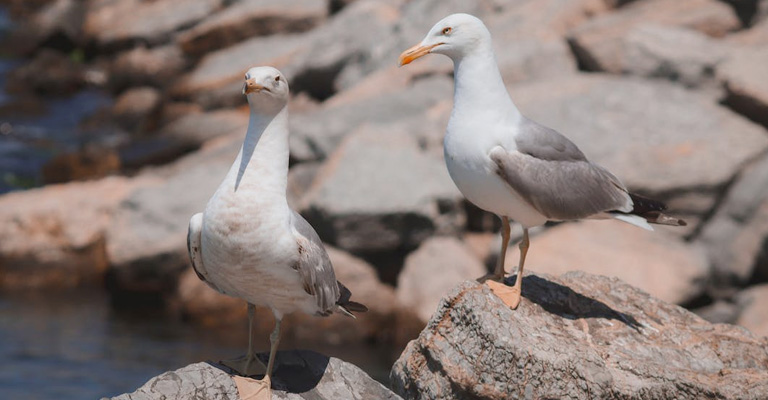Last summer when I visited Myrtle Beach in South Carolina, seagulls were flying everywhere. It was a sight worth watching. They are often social and interact nicely when you offer them food.
The Seagulls are best known as the coastal birds. They are found mainly by the coast in summer in North and South America, the Caribbean, Europe, and Australia, and even islands around Antarctica.
Do you know the oldest seagull to ever live was 49 years old and had a name too – Herring Gull. No, not all the seagulls may live this long. Most of the seagulls enjoy an average life of 10-25 years.
Meanwhile, a lot of factors can influence their lifestyle and life span. We can help the species build a safe habitat by learning how long they live.

How Long Does A Seagull Live?
On average, the lifespan of a seagull ranges from 10 to 25 years in the wild. However, some species have been known to live even longer.
Over 50 species of seagulls are available all around the world. And all of them have different life cycles. Larger species, such as the Great Black-backed Gull, tend to live longer than smaller species like the Ring-billed Gull.
Size and competition are one of the leading factors to affect the life span of a Seagull. Here’s a list of life cycles for some popular Seagull species.
- Herring Gull
Scientific Name: Larus argentatus
Life Span: They live 5 to 20 years in the wild, but some of them are known to live up to 30 years or more.
- Great Black-backed Gull
Scientific Name: Larus marinus
Life Span: Generally 20 to 25 years in the wild, while some external factors may affect their life limit.
- Ring-billed Gull
Scientific Name: Larus delawarensis
Life Span: 12 to 15 years in the wild.
- California Gull
Scientific Name: Larus californicus
Life Span: On average, 20 years.
- Western Gull
Scientific Name: Larus occidentalis
Life Span: 15 to 20 years
- Glaucous-winged Gull
Scientific Name: Larus glaucescens
Life Span: Generally 15 to 20 years
- Laughing Gull
Scientific Name: Leucophaeus atricilla
Life Span: On an average, 15 to 20 years
- Black-headed Gull
Scientific Name: Chroicocephalus ridibundus
Life Span: Around 10 to 15 years - Ivory Gull
Scientific Name: Pagophila eburnea
Life Span: Estimated to be around 15 to 20 years - Kittiwake
Scientific Name: Rissa spp.
Life Span: The Black-legged Kittiwake can live around 12 to 15 years.
Let’s not forget that, external factors like food availability, predation, environmental conditions, and human interference can highly demotivate their life choices and overall life length.
Additionally, there are over 40+ seagull species available. And we have mentioned only the most popular ones here. How other factors may affect them, is also a point of our discussion today. Let’s learn together.
External Factors Affecting Seagull Lifespan

Seagulls are highly adaptable. They can survive in a variety of habitats. However, several factors like environmental pollution, predators, threats, and even human interference can affect how long they live.
It starts here,
Environmental Pollution
Our contribution to pollution leaves a huge impact on nature and its habitat. The seagulls are not free from this too.
The birds are really human-friendly. Most species live around our locality, within the urban region. Here, they have access to our foods and supplements, which may not be too nutritional for them.
The salty foods we consume like french fries, burger are often left out in the bin and become stale. Such foods are too harmful for the birds. Additionally, meat fats and caffeine can also significantly inflame their stomach.
Furthermore, noise and air pollution are also likely to affect their lifespan. Based on a report from Air Quality, the United States have 66 million tons of pollutants released into the air in 2022.
The environment we created, is not even safe for us, let alone the seagulls and other creatures. In contrast, the seagulls living in the wild, tend to have a longer lifespan, that’s what the experts say.
Predatory Threats
It’s all about which stage of the food chain you belong to. Like any other birds, seagulls are also vulnerable to predators.
Birds are clever and they usually don’t breed or lay eggs until they feel safe. Seagulls generally lay eggs on sands or lands that are not easily invadeable. But some species like herring gulls or lesser black-backed gulls build their nest on rooftops or trees.
The eggs and chicks are often easy targets of other predator birds like eagles. Sometimes, other reptiles like tortoises or alligators can also terrorize their habitats. Furthermore, sometimes we also rampage their nest from our properties or destroy their eggs.
Other times, adult seagulls can fall prey to larger birds of prey or even terrestrial predators like raccoons and foxes.
Our Role In It
Humans, our kind can both positively and negatively impact the seagulls’ lifespan.
Some seagull populations take advantage of human activities. We provide them with a consistent food source, such as scavenging at landfills or taking advantage of leftovers in urban areas.
On the other hand, we also disturb their nest and peaceful living with different types of pollution.
Plastic Pollution
One alarming factor we shouldn’t neglect anymore is the use of plastic. Other pollutants like air, noise, and water do affect any living beings badly.
Plastic pollution is the one that drastically affects the sea life and the birds. Over 8-9 million metric tons of plastic end up in the ocean. This leaves us with a tragic number of 1 million seabird deaths due to plastic, and that includes the seagulls too.
It is high time, we should not neglect plastic pollution anymore and take it to our concern.
In Summary,
Seagulls are peaceful and chirping creatures. Their average life span is between 10 to 15 years unless they are hunted down or, pollution catches them faster before life does.
It is our duty to help them survive and balance the ecosystem. Let’s not forget, that every living creature contributes to the well-being of Mother Nature.
We hope now you know more about the beautiful birds and the right answer to how long does a seagull lives.
We share regular updates on Birds and Birds’ lives, feel free to stay in touch with us to learn more. Also, you can help us grow by sharing our articles on your favorite social platform.